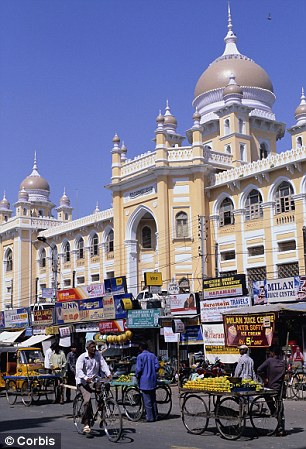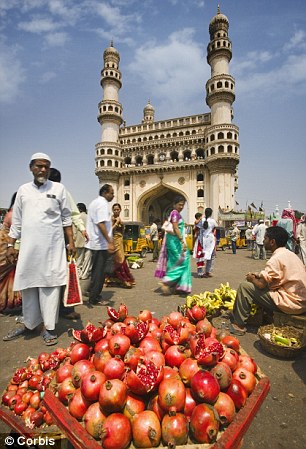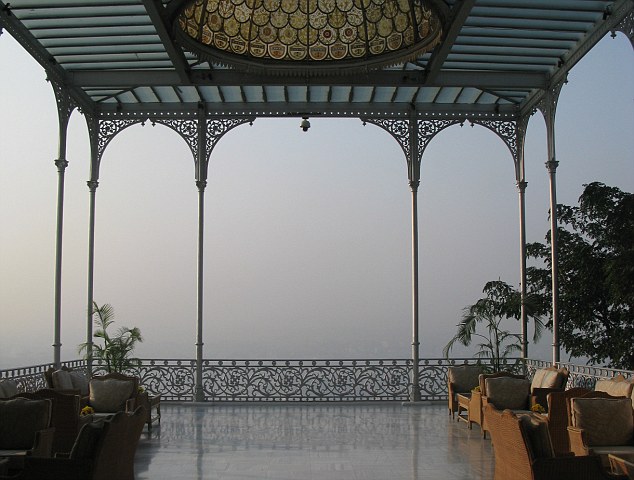Partying is a pastime in India. On my first evening at Falaknuma palace in Hyderabad, I ask the waiter what the drum beating is all about – the city is twinkling, flashing, jingling, rattling away below. ‘A wedding,’ he says, ‘there’s always a wedding. But we celebrate everything in India. Thirty members of the family will wave off a nephew at the airport.’ Perhaps that’s why you can’t enter Hyderabad’s terminal without a ticket (it’s one of the smartest airports in the world) – they’d be inundated. This ancient city, built on the Musi River, has an optimistic outlook. On a tour of old Hyderabad we pass school children from St Mary’s Brilliant School and some from the School of Success. That, and their neatly starched uniforms, must surely inspire good grades. 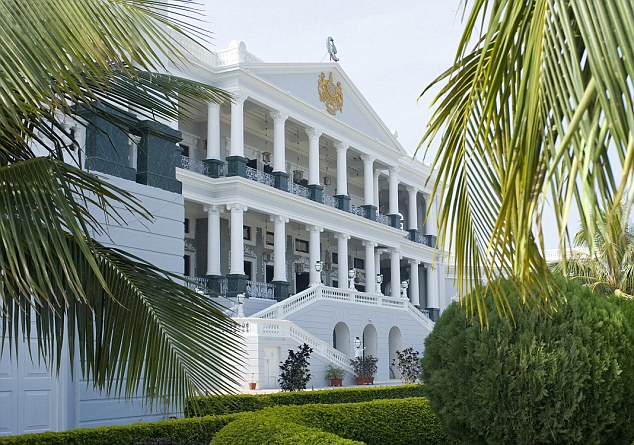
Living the high life: Grand Falaknuma offers guests the chance to live like a king
At Golconda Fort, which dates from 11th century, a sign post points The Way to Up. When you reach Up, the city spans out beneath you, smoking quietly away (they burn rubbish here). Hyderabad is characterised by the rocky outcrops of Central India’s Deccan Plateau, which you can see from the top of Golconda. There’s a campaign (Society to Save Rocks) to protect the rocks because people kept chipping away at them for materials to build their homes. There is plenty of rock left, though, to render the landscape biblical. The fort itself hints at what the city once was – elegant, spacious and green. Golconda was sacked and destroyed by Mughals in 17th century. Now it’s full of bubbly school parties and courting couples. The Qutub Shahi King’s burial ground, which you can see from Up, has a carefree feel too – with impromptu games of cricket being played on the lawns. This strange park is filled with domed tombs, beneath which the Kings and Queens of Golconda and their dancers lie. Voices echo inside, and there’s a coffin draped with fraying sari fabric in the middle of an otherwise empty space. The domes used to be covered in mosaic, which has all but gone. Large crows decorate the roofs instead. 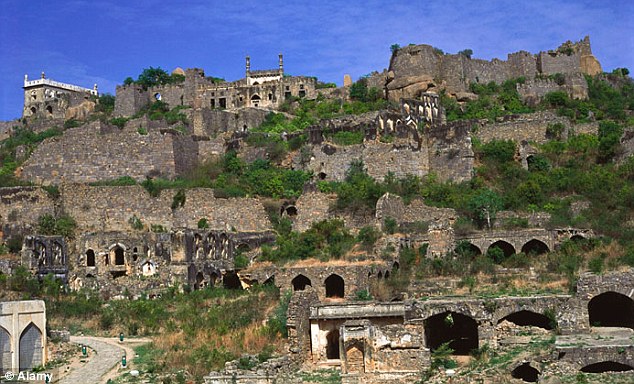
Fort with a view: Golconda, built in the 11th century, affords views right across the city
It’s business as usual on the streets of the old town, where life is in full noisy flow. Pomegranates are piled on rickety carts, discarded veg litter the street, sellers proffer orange segments from filthy fingers. But Hyderabad is famous for glitz. Not only for Tollywood – Bollywood movies are filmed here – but for glittery lacquer bracelets and pearls, which are strung and sold. Laad Bazaar is like London’s Oxford Street on Christmas Eve – but stickier.
The city became rich on diamonds – it’s home to 21 diamond mines – and Nizam VI (Royal ruler of Hyderabad from 1869-1911) owned one so large – the Jacob Diamond – he used it as a paper weight. This was a man who never wore the same pair of socks twice. The hefty jewel is now in a bank vault. The Nizams have five palaces in Hyderabad. Falaknuma, where I am staying, overlooks the city and has recently emerged from a ten-year restorationprogramme with Taj hotels.
Colour explosion: From the high life to street life, the vibrancy of Hyderabad can be felt everywhere
Falaknuma means mirror of the sky in Telugu (the lyrical sounding language of this state) and the hotel is painted to reflect Hyderabad’s skyline. Princess Esra Jah worked with Taj on the project and was so exacting, when it came to the shade of the walls, they painted the exterior over 30 times. It was worth it. The gentle grey melds with the pink hazy sky. The palace was originally built by a former Prime Minister of Hyderabad – Nawab Vikar-al-Umra. We share a star sign. I am a Scorpio too. The PM decreed that Falaknuma be built in the shape of the snappy arachnid, so the two northerly wings represent the sting. Such was the extravagance, he was bankrupted. Thankfully, Nizam VI was able to foot the bill. He paid 6.8 million rupees for it and, in 1897, Falaknuma became a royal palace and residence. If Prince Charles goes ahead with his idea to turn Buckingham Palace into a hotel, he should visit.
Retreat: Away from the city, the hotel’s terrace offers peace and seclusion
Not only has the palace hosted countless Royals and dignitaries – Queen Mary and King George were here in 1906 and the Aga Khan’s signature is in the guestbook. Every visitor is a guest of the Princess. The staff are ridiculously attentive (you really do feel like a Nizam). And staying here is like being allowed behind the ropes at Chatsworth House. You can stay in the Royal Suite (if you can afford to splash out $10,000 a night), recline in the Queen’s artful gossip room, take afternoon tea in the Jade room and even use the Nizam’s snooker cues. It’s a spoiling experience in sublime surroundings. For me, a jasmine martini on the elegant balcony, with Hyderabad sparkling and rumbling away below, is the gold dusting on the richest of cakes. Perhaps because I am a fellow Scorpio, I feel thoroughly at home.
Travel Facts
Cox & Kings arrange luxury tours to India (0845 154 8941 www.coxandkings.co.uk). A six-night / eight-day private tour to Mumbai and Hyderabad is priced from £2,495 per person. Price includes three nights at The Taj Mahal Palace Mumbai (Luxury Grand Sea View room in Palace Wing) and three nights at the Taj Falaknuma Palace (Palace room), international and domestic flights, airport transfers and accommodation with breakfast daily.
source://www.dailymail.co.uk / Daily Mail Online / TRAVEL MAIL / Home> Travel/ by Jenny Wad / December 20th, 2011
